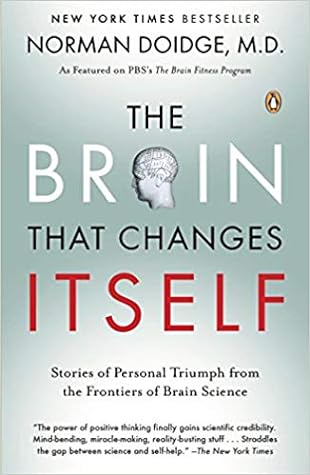More on this book
Community
Kindle Notes & Highlights
Read between
July 27 - August 4, 2018
Brain scans show that during the first two years of life, the mother principally communicates nonverbally with her right hemisphere to reach her infant’s right hemisphere.
The newest brain scans show that when we dream, that part of the brain that processes emotion, and our sexual, survival, and aggressive instincts, is quite active. At the same time the prefrontal cortex system, which is responsible for inhibiting our emotions and instincts, shows lower activity. With instincts turned up and inhibitions turned down, the dreaming brain can reveal impulses that are normally blocked from awareness.
It usually takes three to six weeks for antidepressants to work in humans—perhaps coincidentally, the same amount of time it takes for newly born neurons in the hippocampus to mature, extend their projections, and connect with other neurons. So we may, without knowing it, have been helping people get out of depression by using medications that foster brain plasticity. Since people who improve in psychotherapy also find that their memories improve, it may be that it also stimulates neuronal growth in their hippocampi.
Psychoanalysis is often about turning our ghosts into ancestors, even for patients who have not lost loved ones to death. We are often haunted by important relationships from the past that influence us unconsciously in the present. As we work them through, they go from haunting us to becoming simply part of our history. We can turn our ghosts into ancestors because we can transform implicit memories—which we are often not aware exist until they are evoked and thus seem to come at us “out of the blue”—into declarative memories that now have a clear context, which makes them easier to recollect
...more
Gage’s theory is that in a natural setting, long-term fast walking would take the animal into a new, different environment that would require new learning, sparking what he calls “anticipatory proliferation.” “If we lived in this room only,” he told me, “and this was our entire experience, we would not need neurogenesis. We would know everything about this environment and could function with all the basic knowledge we have.” This theory, that novel environments may trigger neurogenesis, is consistent with Merzenich’s discovery that in order to keep the brain fit, we must learn something new,
...more
Studying the mice, the team found that learning how to use the other toys, balls, and tubes didn’t make new neurons, but it did cause the new neurons in the area to live longer. Elizabeth Gould also found that learning, even in a nonenriched environment, enhances survival of stem cells. Thus physical exercise and learning work in complementary ways: the first to make new stem cells, the second to prolong their survival.
The more education we have, the more socially and physically active we are, and the more we participate in mentally stimulating activities, the less likely we are to get Alzheimer’s disease or dementia. Not all activities are equal in this regard. Those that involve genuine concentration—studying a musical instrument, playing board games, reading, and dancing—are associated with a lower risk for dementia. Dancing, which requires learning new moves, is both physically and mentally challenging and requires much concentration. Less intense activities, such as bowling, babysitting, and golfing,
...more
Recent research shows that exercise stimulates the production and release of the neuronal growth factor BDNF, which, as we saw in chapter 3, “Redesigning the Brain,” plays a crucial role in effecting plastic change. In fact, whatever keeps the heart and blood vessels fit invigorates the brain, including a healthy diet. A brutal workout is not necessary—consistent natural movement of the limbs will do. As van Praag and Gage discovered, simply walking, at a good pace, stimulates the growth of new neurons.


